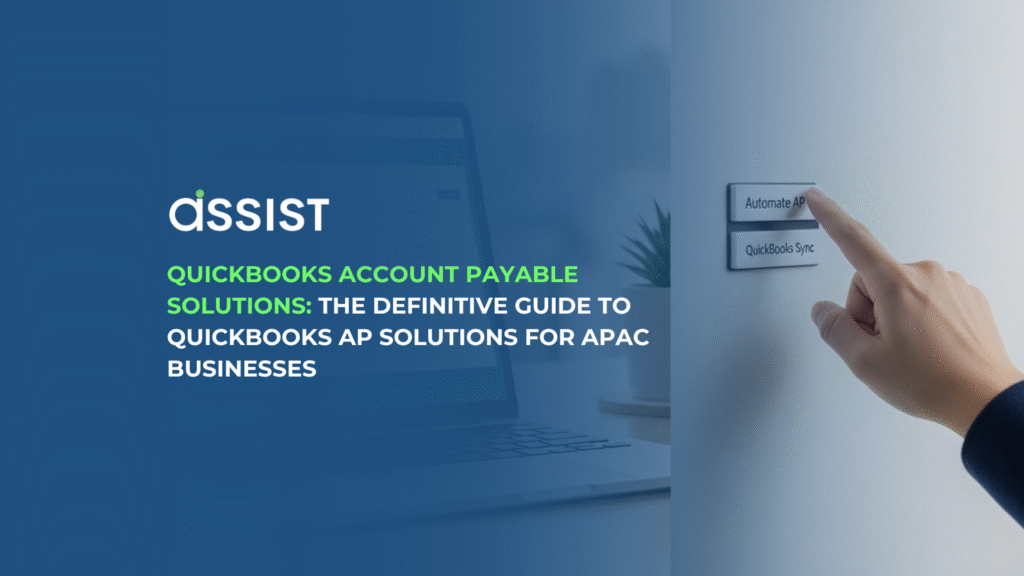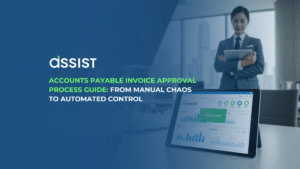As a finance leader or business owner in the dynamic APAC region, you know that Accounts Payable (AP) isn’t just about paying bills—it’s about cash flow, vendor relationships, and regulatory compliance. Managing AP efficiently is a core driver of growth, which is why so many businesses rely on QuickBooks as their central accounting ledger.
The question then arises: Is your current QuickBooks setup enough, or do you need a specialized Accounts Payable solution?
The best QuickBooks Accounts Payable solution for your business depends entirely on your invoice volume, need for complex approval workflows, and whether you conduct multi-entity or global payments. The right solution for high-growth businesses will likely be an external AP automation tool that seamlessly integrates with QuickBooks, offering advanced features like OCR, dynamic approvals, and compliance support, whereas smaller firms may utilize QuickBooks’ native features. Continue reading this definitive guide to qualify your exact needs and find the optimal solution that maximizes efficiency and financial control.
The SERP landscape shows a clear split: QuickBooks’ native features vs. a vast ecosystem of third-party automation tools. Navigating this choice, especially when your financial stability is at stake (making this a YMYL topic), requires a definitive, objective guide. That’s exactly what this is. We’ll walk through a qualification process to determine your exact needs, helping you choose the right solution to move beyond manual data entry and into the world of seamless automation. In fact, if you’re looking for a good starting point, you can review the top 5 reasons to use automated bookkeeping (https://www.assist.biz/bookeeping/top-5-reasons-to-use-automated-bookkeeping/) as you consider your strategy.
Step 1: Evaluating QuickBooks’ Native Accounts Payable Features (The “Do I Need an Upgrade?” Test)
Before you commit time and resources to integrating a new software, it’s essential to assess the capabilities you already own. QuickBooks has steadily introduced native features aimed at streamlining AP. For small businesses with lower transaction volumes or simpler needs, these built-in tools might be all you require.
Within the QuickBooks ecosystem, the native solution allows you to:
- Enter and Track Bills: You can record vendor invoices and set due dates, ensuring you maintain a detailed overview of your outstanding liabilities.
- Process Payments: QuickBooks supports check printing and often integrates with local banking services or platforms like QuickBooks Payments for direct electronic payments.
- Manage Documents: Newer versions, particularly QuickBooks Online Advanced, allow users to snap and upload documents like receipts and bills, using a basic level of automation for data entry.
A Feature-by-Feature Breakdown and the Critical Limitations
Understanding the specific QuickBooks plan you are on is critical, as feature availability changes drastically. For example, QuickBooks Online Plus or Advanced typically offers more robust bill management and approval workflows than Simple Start.
However, even the most feature-rich native QuickBooks platform runs into limitations that trigger the need for external tools—the “Tipping Point.” This is where the cost-benefit analysis of AP automation truly begins:
- High Volume Processing: If you handle more than 50-100 vendor bills per month, the manual effort of data entry and verification, even with partial document upload features, quickly becomes unsustainable. Your AP team’s time is better spent on exception handling than keying in data.
- Complex Approval Workflows: Native QuickBooks offers rudimentary approval. If your company requires a multi-tiered approval matrix (e.g., approval based on department, amount, or project), the native solution will fail to provide the necessary controls, leaving compliance gaps. You can learn more about this by reading about the invoice approval matrix definition, benefits, and how to use it (https://www.assist.biz/tips/invoice-approval-matrix-definition-benefits-and-how-to-use-it/).
- Multi-Entity or Multi-Currency Operations: For fast-growing APAC businesses operating across borders, managing multiple legal entities or frequently paying vendors in USD, SGD, or MYR becomes cumbersome. External AP tools are built to handle these complex transactions and currency conversions seamlessly.
If you recognize your business exceeding these limits, your next step is to explore dedicated third-party solutions. For a broader context, consider delving into a complete guide to accounts payable accounts receivable (https://www.assist.biz/tips/a-complete-guide-to-accounts-payable-accounts-receivable/) management.
Step 2: The Need for External Automation – When and Why APAC Businesses Look Beyond Native Solutions
Once you cross the “Tipping Point,” AP automation software becomes a necessity, not a luxury. These external solutions plug into QuickBooks, acting as a specialized AP cockpit that handles the heavy lifting before syncing summarized journal entries back to your ledger.
The primary reason APAC businesses seek these tools is to solve the complex financial and operational challenges that native accounting software isn’t designed to address. The need for advanced tools highlights why how bookkeeping AI can change the way you do business (https://www.assist.biz/general/how-can-bookkeeping-ai-change-the-way-you-do-business/) is becoming a core theme in regional finance.
Crucial Features That Native QuickBooks Lacks
- True Invoice Data Capture (OCR and AI): Native QuickBooks relies on basic scanning. Advanced solutions offer Optical Character Recognition (OCR) combined with AI to achieve accuracy rates of 98% or higher, automatically identifying vendor, line items, tax, and currency, eliminating manual data entry errors. This process is detailed in A comprehensive guide to OCR (Optical Character Recognition) (https://www.assist.biz/general/a-comprehensive-guide-to-ocr-optical-character-recognition/).
- Sophisticated Approval Workflows: External tools offer customizable, dynamic approval rules that route bills instantly based on pre-set criteria (amount, vendor, GL code), vastly improving internal controls and reducing compliance risk.
- Advanced Payment Automation: Beyond simple check printing, AP automation platforms facilitate global payments, automate two-way or three-way matching, and manage vendor compliance (like tax form collection) before a single payment is released.
By integrating a specialized tool, you minimize human error, accelerate the financial close process, and free up your finance team to focus on strategic work, ultimately strengthening your financial stability—a crucial component of the YMYL standard.
Step 3: Comparative Analysis – Top QuickBooks AP Automation Solutions
The market for QuickBooks AP solutions is robust, with several major players vying for your business. To establish true E-E-A-T (Expertise, Experience, Authoritativeness, and Trust), we must move beyond feature lists and analyze the solutions based on integration performance, cost, and complexity.
When choosing a partner, remember your focus must be on solutions with a seamless integration with QuickBooks capability.
Key Comparison Factors for QuickBooks Integration
Your selection process should prioritize the following factors:
| Factor | Description | Why it Matters for QuickBooks Users |
| Integration Depth | How frequently and how seamlessly data flows between the AP tool and QuickBooks. | Does it support both QuickBooks Desktop and Online? Is the sync real-time or batch? Look for robust APIs. |
| Implementation & Switching Costs | The time and effort required for setup, training, and migrating existing vendor data. | A complex switch can negate the time savings of automation. Prioritize solutions with simple, guided setup (often reflected in their pricing (https://www.assist.biz/pricing/) structure). |
| Vendor Management & Global Payments | Ability to handle different currencies, tax compliance (e.g., e-invoicing preparation), and payment methods (ACH, cross-border wire). | Crucial for APAC businesses dealing with regional and international vendors, ensuring compliance and timely payments. |
| User Experience (UX) & Training | The intuitiveness of the interface and the quality of documentation or guided tours. | A complex system will lead to poor user adoption and require excessive internal training time. |
To make a fully informed choice, it’s highly recommended to look at case studies from businesses similar to yours to confirm real-world performance.
Qualification Matrix: Finding Your Perfect AP Solution
Instead of merely reviewing features, use this matrix to qualify your business need against the common solutions you see topping the SERPs (AvidXchange, MineralTree, Tipalti, etc.).
| Your Business Need | QBO Native (Self-Qualified) | Solution A (High Volume, Complex Workflow) | Solution B (Global Payments, Multi-Entity) | Solution C (SMB, Cost-Effective Automation) |
| Monthly Bill Volume < 50 | ✅ Best Fit | ❌ Overkill | ❌ Overkill | 🟡 Possible Fit |
| Need Multi-Tiered Approval | ❌ Fails | ✅ Best Fit | ✅ Best Fit | 🟡 Possible Fit |
| Requires Global Payments | ❌ Fails | 🟡 Good Fit | ✅ Best Fit | 🟡 Possible Fit |
| Focus on E-Invoicing Compliance | 🟡 Partial | ✅ Best Fit | ✅ Best Fit | ✅ Best Fit |
Choosing the wrong solution can lead to integration headaches and significant financial waste. Use this objective analysis as your guide to making a financially sound decision.
Step 4: Maximizing E-E-A-T – The Importance of Security and Compliance in AP
In the financial world, trust is everything. For a topic related to money (YMYL), Raters apply stringent Page Quality standards, demanding verifiable E-E-A-T from the solution provider and the content itself. Your chosen AP solution must demonstrate this commitment, particularly in security and regional compliance.
A solution must provide robust security controls—not just for data access, but for preventing payment fraud and ensuring data integrity. This focus builds Trust with your vendors and auditors. When researching a platform, ask critical questions about their certification, data encryption, and disaster recovery. You can find out more about us (https://www.assist.biz/about-us/) and the standards we uphold to build this trust.
Furthermore, AP automation tools are now essential compliance partners. In APAC, countries like Malaysia and Singapore are driving mandates for e-invoicing. An effective AP solution must handle these complex new standards, reducing your compliance burden. Understanding regulations like the Malaysian e-invoicing mandate is crucial, and your automation tool should simplify this, ensuring you are audit-ready. A woven link to the e-invoice Malaysia a complete guide (https://www.assist.biz/general/e-invoice-malaysia-a-complete-guide/) can provide more detail on this critical regulatory change.
Your Expert Solution: Achieving Seamless QuickBooks Accounts Payable Automation with Assist
After objectively qualifying your needs and reviewing the complexity of the market, you might be looking for a solution built specifically to provide affordable, deep QuickBooks integration that scales with your APAC business needs.
Assist is designed to be the expert-level AP solution that provides the OCR accuracy, customizable approval workflows, and regional compliance focus (including e-invoicing readiness) that native QuickBooks lacks—all without the enterprise-level complexity or pricing. Our platform offers a seamless integration with QuickBooks (https://www.assist.biz/our-solution/integration-with-quickbooks/) (both Online and Desktop) and uses Assist Bookkeeping AI to transform your invoice processing from minutes per bill to seconds. You can easily see how it works (https://www.assist.biz/see-how-it-works/) with QuickBooks in action.
Ready to Transform Your AP? Try Assist Today
If you’re ready to achieve the highest level of AP efficiency and financial control that perfectly complements your QuickBooks ledger, we invite you to experience the power of our solution firsthand. Register for using Assist solution and try it for free at https://app.assist.biz/auth/register to start transforming your accounts payable immediately.




